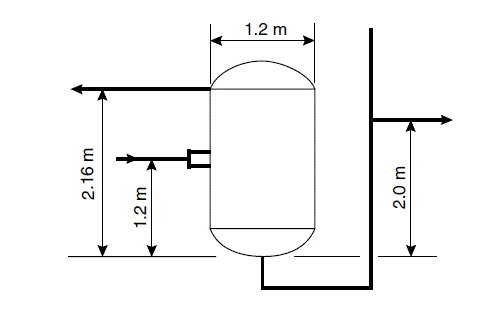Design a decanter to separate a light oil from water.
The oil is the dispersed phase.
Oil, flow rate 1000 kg/h, density 900 kg / m ^{3}, viscosity 3 mN s / m ^{2}.
Water, flow rate 5000 kg/h, density 1000 kg / m ^{3}, viscosity 1 mN s / m ^{2}.
Design a decanter to separate a light oil from water.
The oil is the dispersed phase.
Oil, flow rate 1000 kg/h, density 900 kg / m ^{3}, viscosity 3 mN s / m ^{2}.
Water, flow rate 5000 kg/h, density 1000 kg / m ^{3}, viscosity 1 mN s / m ^{2}.
u_{d}=\frac{\left(150 \times 10^{-6}\right)^{2} 9.81(900-1000)}{18 \times 1 \times 10^{-3}} =-0.0012 m / s ,-1.2 mm / s \text { (rising) } (10.7)
As the flow rate is small, use a vertical, cylindrical vessel.
L_{c}=\frac{5000}{1000} \times \frac{1}{3600}=1.39 \times 10^{-3} m ^{3} / s
u_{c} \ngtr u_{d}, \text { and } u_{c}=\frac{L_{c}}{A_{i}}
hence
A_{i}=\frac{1.39 \times 10^{-3}}{0.0012}=1.16 m ^{2}
r=\sqrt{\frac{1.16}{\pi}}=0.61 m
diameter = 1.2 m
Take the height as twice the diameter, a reasonable value for a cylinder:
height = 2.4 m
Take the dispersion band as 10 per cent of the height = 0.24 m
Check the residence time of the droplets in the dispersion band =\frac{0.24}{u}=\frac{0.24}{00012}=200 s (\sim 3 min )
This is satisfactory, a time of 2 to 5 min is normally recommended. Check the size of the water (continuous, heavy phase) droplets that could be entrained with the oil (light phase).
\text { Velocity of oil phase }=\frac{1000}{900} \times \frac{1}{3600} \times \frac{1}{1.16} =2.7 \times 10^{-4} m / s (0.27 mm / s )
From equation 10.7
d_{d}=\left[\frac{u_{d} 18 \mu_{c}}{g\left(\rho_{d}-\rho_{c}\right)}\right]^{1 / 2}
so the entrained droplet size will =\left[\frac{2.7 \times 10^{-4} \times 18 \times 3 \times 10^{-3}}{9.81(1000-900)}\right]^{1 / 2} =1.2 \times 10^{-4} m =120 \mu m
which is satisfactory; below 150 μm.
Piping arrangement
To minimise entrainment by the jet of liquid entering the vessel, the inlet velocity for a decanter should keep below 1 m/s.
\text { Flow-rate }=\left[\frac{1000}{900}+\frac{5000}{1000}\right] \frac{1}{3600}=1.7 \times 10^{-3} m ^{3} / s
\text { Area of pipe }=\frac{1.7 \times 10^{-3}}{1}=1.7 \times 10^{-3} m ^{2}
\text { Pipe diameter }=\sqrt{\frac{1.7 \times 10^{-3} \times 4}{\pi}}=0.047 m \text {, say } 50 mm
Take the position of the interface as half-way up the vessel and the light liquid off-take as at 90 per cent of the vessel height, then
z_{1}=0.9 \times 2.4=2.16 m
z_{3}=0.5 \times 2.4=1.2 m
z_{2}=\frac{(2.16-1.2)}{100 n} \times 900+1.2=2.06 m (10.5)
say 2.0 m
Proposed design
Drain valves should be fitted at the interface so that any tendency for an emulsion to form can be checked; and the emulsion accumulating at the interface drained off periodically as necessary.
